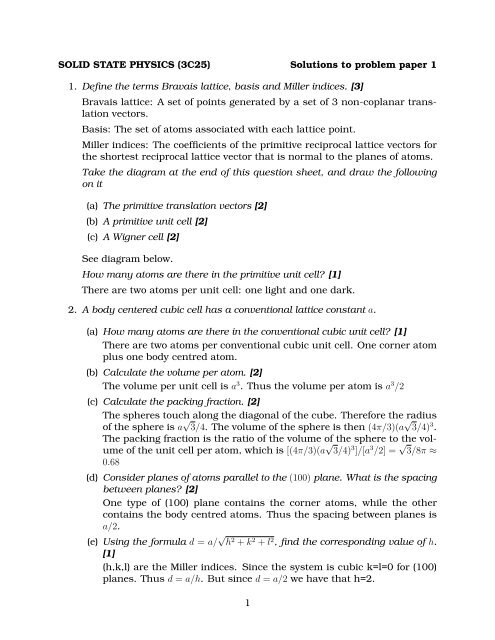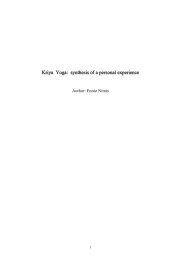SOLID STATE PHYSICS (3C25) Solutions to problem paper 1 1 ...
SOLID STATE PHYSICS (3C25) Solutions to problem paper 1 1 ...
SOLID STATE PHYSICS (3C25) Solutions to problem paper 1 1 ...
You also want an ePaper? Increase the reach of your titles
YUMPU automatically turns print PDFs into web optimized ePapers that Google loves.
<strong>SOLID</strong> <strong>STATE</strong> <strong>PHYSICS</strong> (<strong>3C25</strong>) <strong>Solutions</strong> <strong>to</strong> <strong>problem</strong> <strong>paper</strong> 1<br />
1. Define the terms Bravais lattice, basis and Miller indices. [3]<br />
Bravais lattice: A set of points generated by a set of 3 non-coplanar translation<br />
vec<strong>to</strong>rs.<br />
Basis: The set of a<strong>to</strong>ms associated with each lattice point.<br />
Miller indices: The coefficients of the primitive reciprocal lattice vec<strong>to</strong>rs for<br />
the shortest reciprocal lattice vec<strong>to</strong>r that is normal <strong>to</strong> the planes of a<strong>to</strong>ms.<br />
Take the diagram at the end of this question sheet, and draw the following<br />
on it<br />
(a) The primitive translation vec<strong>to</strong>rs [2]<br />
(b) A primitive unit cell [2]<br />
(c) A Wigner cell [2]<br />
See diagram below.<br />
How many a<strong>to</strong>ms are there in the primitive unit cell? [1]<br />
There are two a<strong>to</strong>ms per unit cell: one light and one dark.<br />
2. A body centered cubic cell has a conventional lattice constant a.<br />
(a) How many a<strong>to</strong>ms are there in the conventional cubic unit cell? [1]<br />
There are two a<strong>to</strong>ms per conventional cubic unit cell. One corner a<strong>to</strong>m<br />
plus one body centred a<strong>to</strong>m.<br />
(b) Calculate the volume per a<strong>to</strong>m. [2]<br />
The volume per unit cell is a 3 . Thus the volume per a<strong>to</strong>m is a 3 /2<br />
(c) Calculate the packing fraction. [2]<br />
The spheres <strong>to</strong>uch along the diagonal of the cube. Therefore the radius<br />
of the sphere is a √ 3/4. The volume of the sphere is then (4π/3)(a √ 3/4) 3 .<br />
The packing fraction is the ratio of the volume of the sphere <strong>to</strong> the volume<br />
of the unit cell per a<strong>to</strong>m, which is [(4π/3)(a √ 3/4) 3 ]/[a 3 /2] = √ 3/8π ≈<br />
0.68<br />
(d) Consider planes of a<strong>to</strong>ms parallel <strong>to</strong> the (100) plane. What is the spacing<br />
between planes? [2]<br />
One type of (100) plane contains the corner a<strong>to</strong>ms, while the other<br />
contains the body centred a<strong>to</strong>ms. Thus the spacing between planes is<br />
a/2.<br />
(e) Using the formula d = a/ √ h 2 + k 2 + l 2 , find the corresponding value of h.<br />
[1]<br />
(h,k,l) are the Miller indices. Since the system is cubic k=l=0 for (100)<br />
planes. Thus d = a/h. But since d = a/2 we have that h=2.<br />
1
(f) Why is this surprising? [2]<br />
The body centred cubic crystal has a cubic cell for which h=1. However<br />
the basis introduces extra planes.<br />
3. When electrons are scattered from a crystal surface<br />
(a) Why does the angle of incidence equal the angle of reflection? [2]<br />
To ensure that the waves scattered off neighbouring surface a<strong>to</strong>ms are<br />
in phase.<br />
(b) Why do you only see reflections at some angles of incidence? [2]<br />
Because only for certain angles of incidence are the waves scattered off<br />
neighbouring planes in phase.<br />
(c) Why can you study only a<strong>to</strong>ms near the crystal surface? [2]<br />
Electrons cannot penetrate deep in<strong>to</strong> a crystal because they are scattered<br />
by the surface layers of a<strong>to</strong>ms.<br />
4. Consider the scattering of x-rays of wavelength λ from a face centred cubic<br />
crystal with cubic lattice constant a.<br />
(a) What are the allowed scattering angles when the scattering is from the<br />
(001) planes of the crystal? (Use Bragg’s law.) [3]<br />
2d sin θ = nλ<br />
d = a/2<br />
⇒ sin θ = nλ<br />
a<br />
(b) Using the simple cubic representation of a face centred cubic crystal,<br />
write down the primitive translation vec<strong>to</strong>rs and calculate the reciprocal<br />
lattice vec<strong>to</strong>rs. [3]<br />
a = a(100) A = 2π<br />
a (100)<br />
b = a(010) B = 2π<br />
a (010)<br />
c = a(001) C = 2π<br />
a (001)<br />
(c) Using the Laue construction, determine the allowed scattering vec<strong>to</strong>rs for<br />
scattering from (001) planes. [4]<br />
In general, a reflection from a (001) surface implies that ∆ k is parallel<br />
<strong>to</strong> C (the primitive reciprocal lattice vec<strong>to</strong>r with indices (001)). From the<br />
Laue construction we know that scattering vec<strong>to</strong>rs must equal reciprocal<br />
lattice vec<strong>to</strong>rs for strong reflection:<br />
2
Thus ∆k = n C = 2πn(001),<br />
where n is an integer.<br />
a<br />
(d) What is the structure fac<strong>to</strong>r for the face centred cubic crystal? [2]<br />
The basis vec<strong>to</strong>rs di are (0, 0, 0), (a/2, a/2, 0), (a/2, 0, a/2), and (0, a/2, a/2).<br />
Let ∆k = h A + k B + l C = 2π<br />
a (h, k, l). Thus ∆k · di is<br />
∆ k · (0, 0, 0) = 0<br />
∆ k · (a/2, a/2, 0) = (h + k)π<br />
∆ k · (a/2, 0, a/2) = (h + l)π<br />
∆ k · (0, a/2, a/2) = (k + l)π<br />
and the structure fac<strong>to</strong>r is therefore<br />
S = f <br />
1 + e i(h+k)π + e i(h+l)π + e i(k+l)π<br />
(e) Which reflections are forbidden? Explain why they are forbidden. [2]<br />
If h, k and l are all even or all odd then we have S = 4f, otherwise<br />
we have S = 0. Thus the forbidden reflections are those which either<br />
one or two of h, k, l is odd. The basis a<strong>to</strong>ms introduce extra planes and<br />
scattering from these planes can create destructive interference, even<br />
though there would be constructive intereference without them.<br />
3
Figure for question 1.<br />
4

















